Operations and Project Management: Principles and Applications at XYZ
VerifiedAdded on 2020/06/06
|18
|5034
|27
Project
AI Summary
This project analyzes operations and project management principles within the context of XYZ organization. It begins with an introduction to the importance of operations management and its various interlinked functions, setting the stage for an examination of XYZ's product offerings, including cookers, washing machines, and televisions. The project then delves into applying management operations principles, including reality, organization, fundamentals, accountability, variance, causality, managed passion, humility, success, and change. The project further explores Six Sigma principles and tools, such as DMAIC (Define, Measure, Analyze, Improve, Control), and lean principles, including defining value, mapping the value stream, creating flow, establishing pull, and pursuing perfection. The project also focuses on the concept of continuous improvement, outlining its importance and providing a plan that addresses areas like promotional events, after-sales services, and consumer feedback. Finally, the project examines product life cycle (PLC) implementation and its effectiveness within the company.
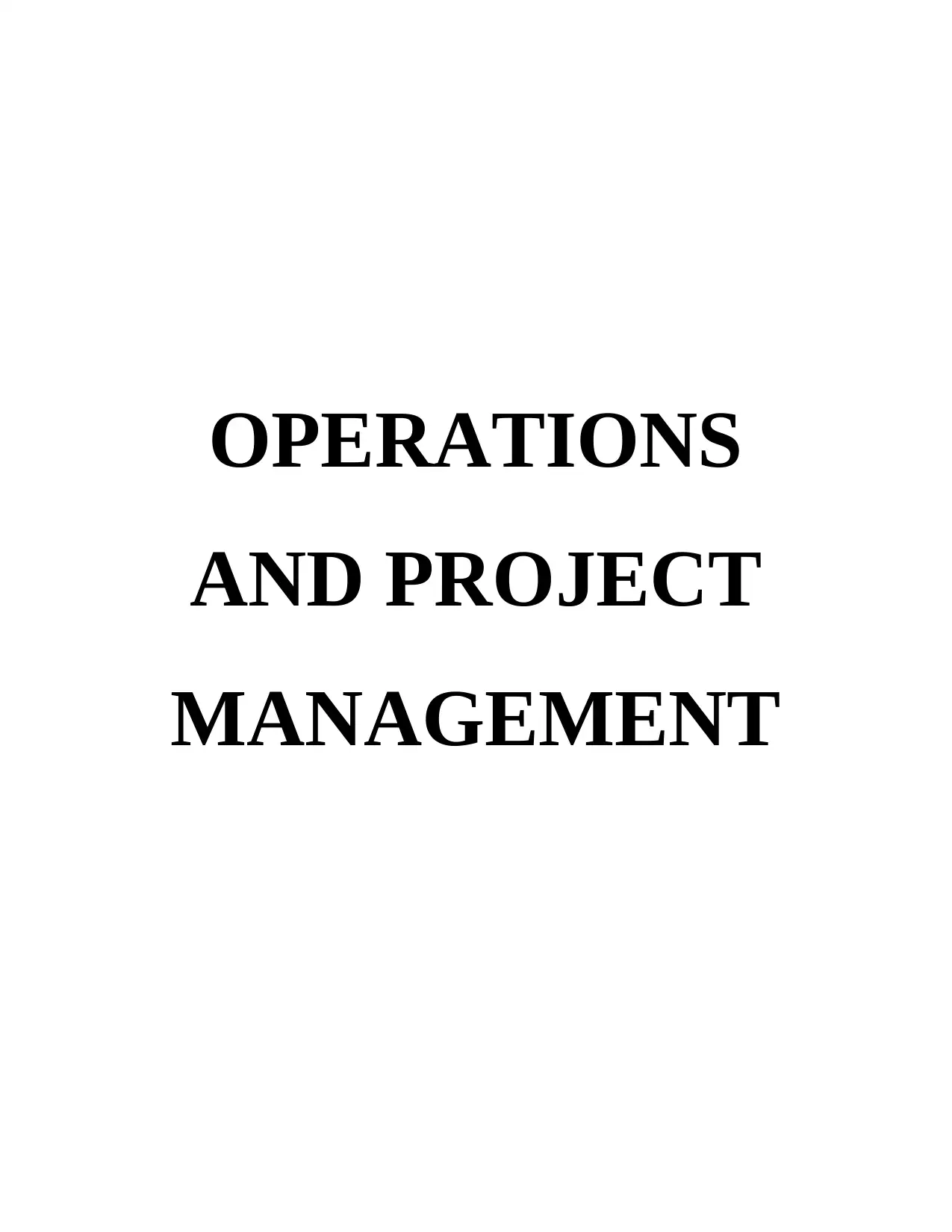
OPERATIONS
AND PROJECT
MANAGEMENT
AND PROJECT
MANAGEMENT
Paraphrase This Document
Need a fresh take? Get an instant paraphrase of this document with our AI Paraphraser
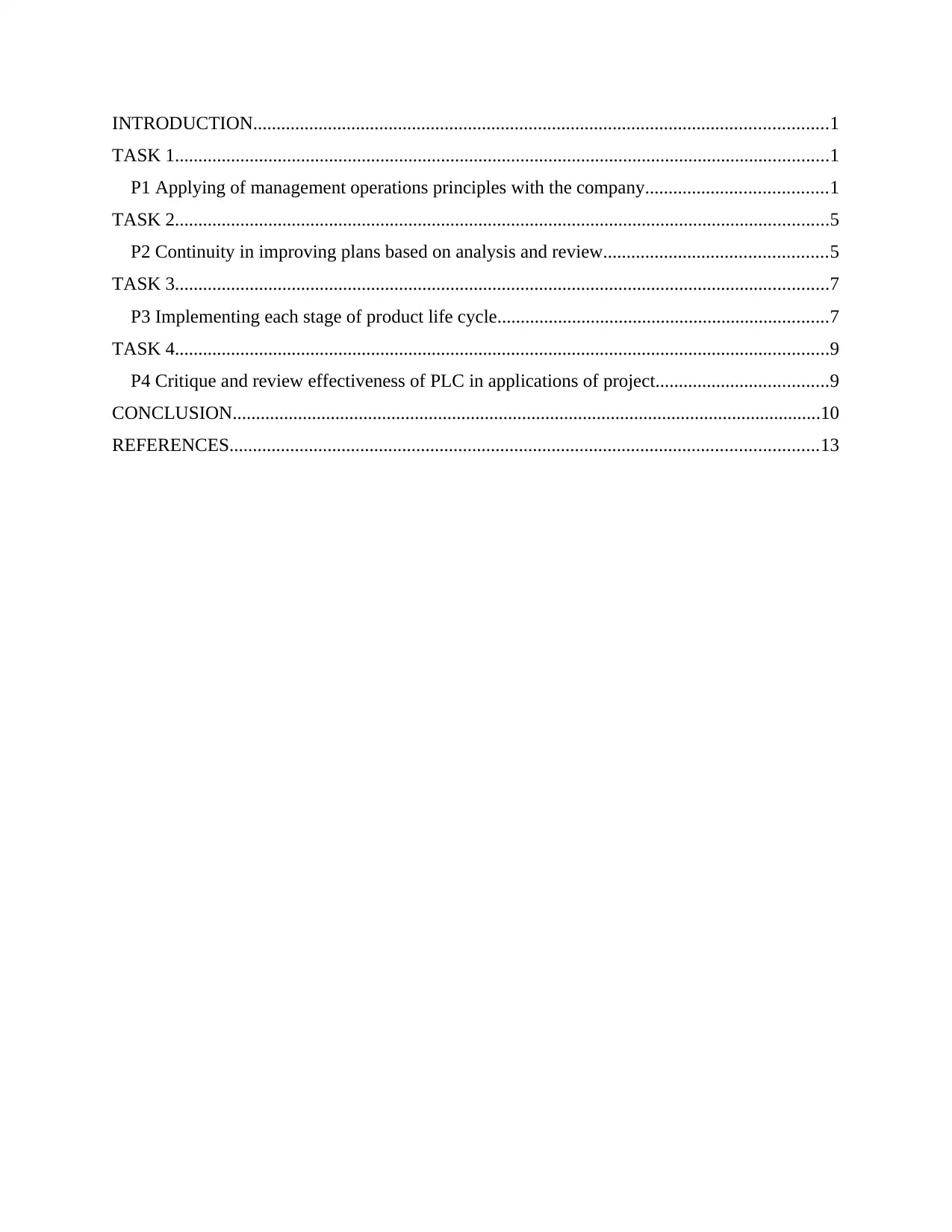
INTRODUCTION...........................................................................................................................1
TASK 1............................................................................................................................................1
P1 Applying of management operations principles with the company.......................................1
TASK 2............................................................................................................................................5
P2 Continuity in improving plans based on analysis and review................................................5
TASK 3............................................................................................................................................7
P3 Implementing each stage of product life cycle.......................................................................7
TASK 4............................................................................................................................................9
P4 Critique and review effectiveness of PLC in applications of project.....................................9
CONCLUSION..............................................................................................................................10
REFERENCES..............................................................................................................................13
TASK 1............................................................................................................................................1
P1 Applying of management operations principles with the company.......................................1
TASK 2............................................................................................................................................5
P2 Continuity in improving plans based on analysis and review................................................5
TASK 3............................................................................................................................................7
P3 Implementing each stage of product life cycle.......................................................................7
TASK 4............................................................................................................................................9
P4 Critique and review effectiveness of PLC in applications of project.....................................9
CONCLUSION..............................................................................................................................10
REFERENCES..............................................................................................................................13
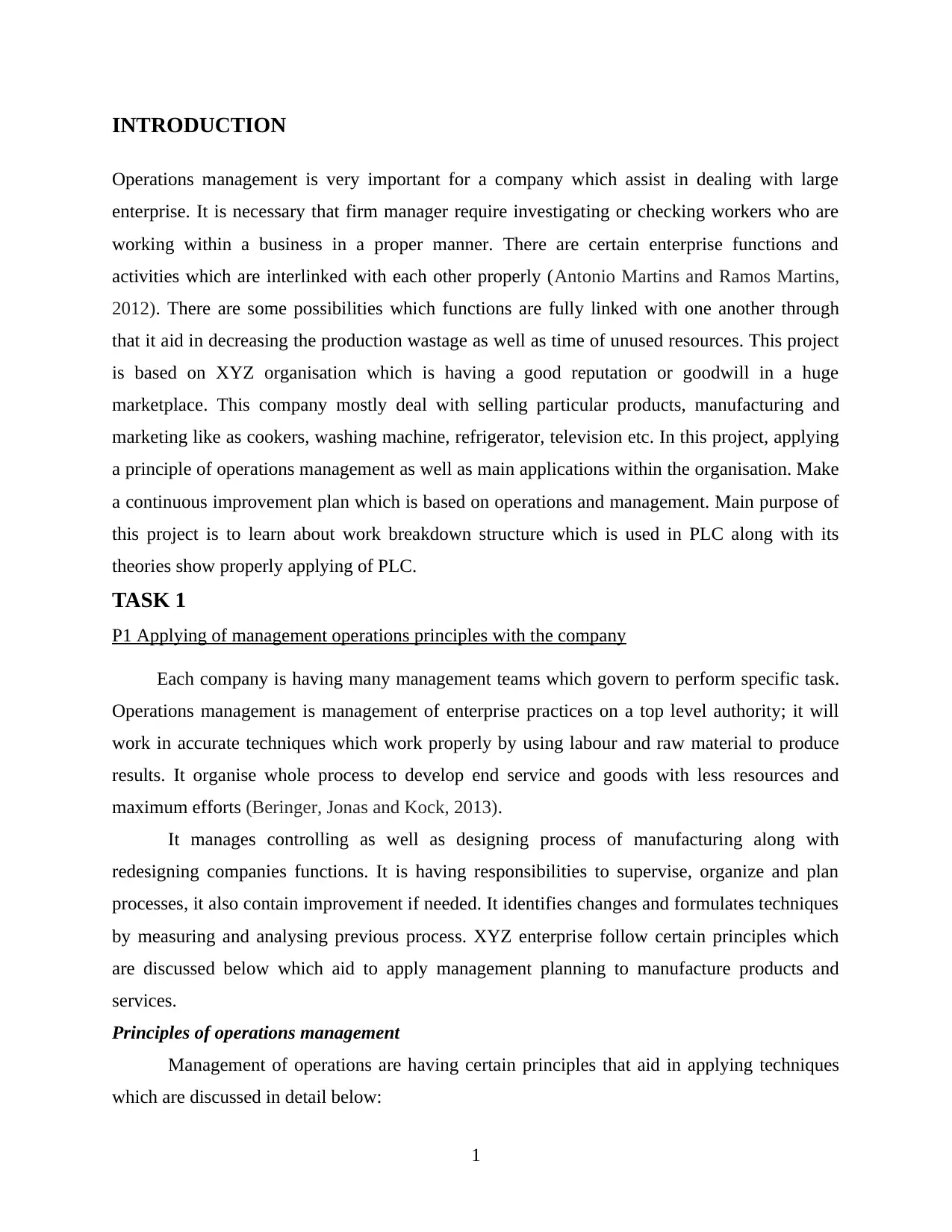
INTRODUCTION
Operations management is very important for a company which assist in dealing with large
enterprise. It is necessary that firm manager require investigating or checking workers who are
working within a business in a proper manner. There are certain enterprise functions and
activities which are interlinked with each other properly (Antonio Martins and Ramos Martins,
2012). There are some possibilities which functions are fully linked with one another through
that it aid in decreasing the production wastage as well as time of unused resources. This project
is based on XYZ organisation which is having a good reputation or goodwill in a huge
marketplace. This company mostly deal with selling particular products, manufacturing and
marketing like as cookers, washing machine, refrigerator, television etc. In this project, applying
a principle of operations management as well as main applications within the organisation. Make
a continuous improvement plan which is based on operations and management. Main purpose of
this project is to learn about work breakdown structure which is used in PLC along with its
theories show properly applying of PLC.
TASK 1
P1 Applying of management operations principles with the company
Each company is having many management teams which govern to perform specific task.
Operations management is management of enterprise practices on a top level authority; it will
work in accurate techniques which work properly by using labour and raw material to produce
results. It organise whole process to develop end service and goods with less resources and
maximum efforts (Beringer, Jonas and Kock, 2013).
It manages controlling as well as designing process of manufacturing along with
redesigning companies functions. It is having responsibilities to supervise, organize and plan
processes, it also contain improvement if needed. It identifies changes and formulates techniques
by measuring and analysing previous process. XYZ enterprise follow certain principles which
are discussed below which aid to apply management planning to manufacture products and
services.
Principles of operations management
Management of operations are having certain principles that aid in applying techniques
which are discussed in detail below:
1
Operations management is very important for a company which assist in dealing with large
enterprise. It is necessary that firm manager require investigating or checking workers who are
working within a business in a proper manner. There are certain enterprise functions and
activities which are interlinked with each other properly (Antonio Martins and Ramos Martins,
2012). There are some possibilities which functions are fully linked with one another through
that it aid in decreasing the production wastage as well as time of unused resources. This project
is based on XYZ organisation which is having a good reputation or goodwill in a huge
marketplace. This company mostly deal with selling particular products, manufacturing and
marketing like as cookers, washing machine, refrigerator, television etc. In this project, applying
a principle of operations management as well as main applications within the organisation. Make
a continuous improvement plan which is based on operations and management. Main purpose of
this project is to learn about work breakdown structure which is used in PLC along with its
theories show properly applying of PLC.
TASK 1
P1 Applying of management operations principles with the company
Each company is having many management teams which govern to perform specific task.
Operations management is management of enterprise practices on a top level authority; it will
work in accurate techniques which work properly by using labour and raw material to produce
results. It organise whole process to develop end service and goods with less resources and
maximum efforts (Beringer, Jonas and Kock, 2013).
It manages controlling as well as designing process of manufacturing along with
redesigning companies functions. It is having responsibilities to supervise, organize and plan
processes, it also contain improvement if needed. It identifies changes and formulates techniques
by measuring and analysing previous process. XYZ enterprise follow certain principles which
are discussed below which aid to apply management planning to manufacture products and
services.
Principles of operations management
Management of operations are having certain principles that aid in applying techniques
which are discussed in detail below:
1
⊘ This is a preview!⊘
Do you want full access?
Subscribe today to unlock all pages.

Trusted by 1+ million students worldwide
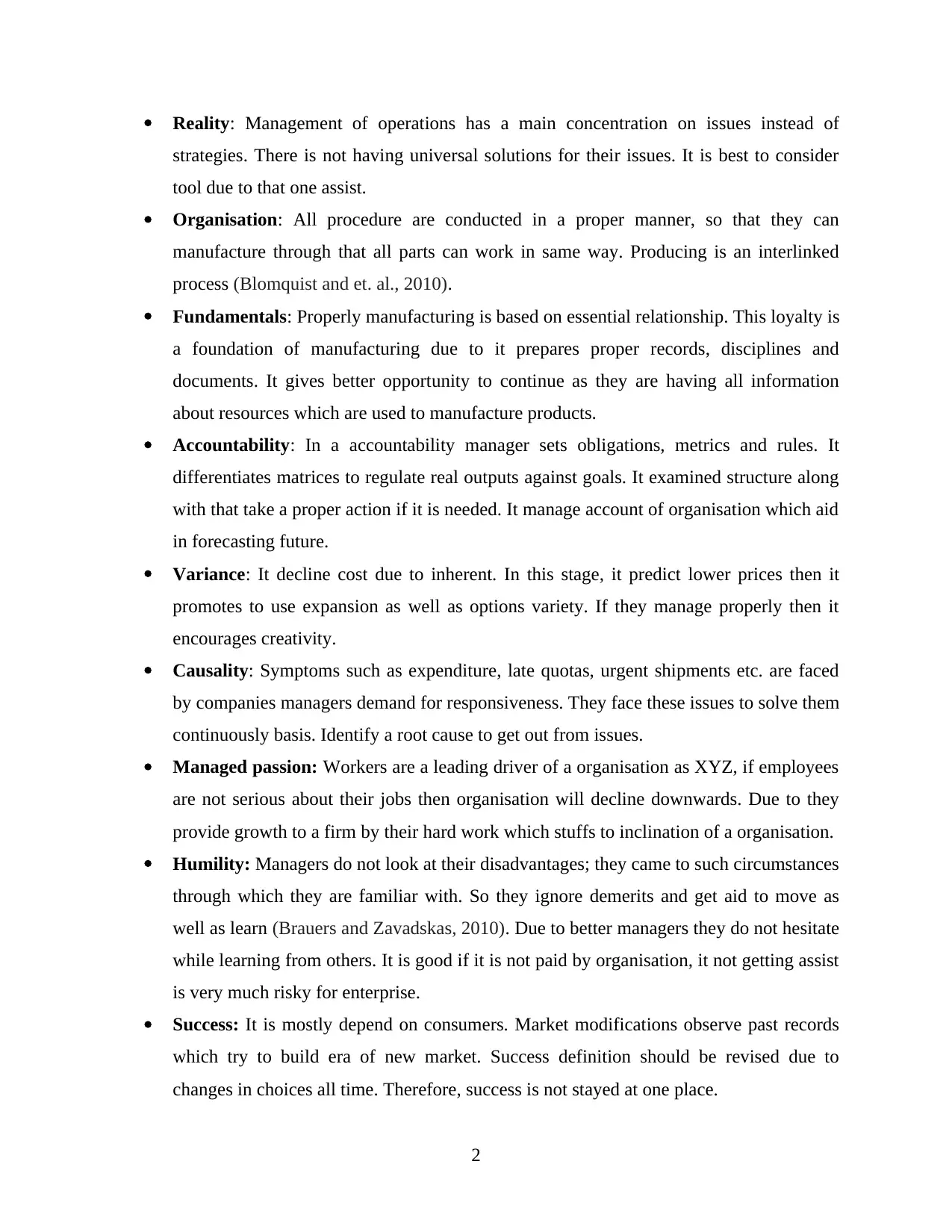
Reality: Management of operations has a main concentration on issues instead of
strategies. There is not having universal solutions for their issues. It is best to consider
tool due to that one assist.
Organisation: All procedure are conducted in a proper manner, so that they can
manufacture through that all parts can work in same way. Producing is an interlinked
process (Blomquist and et. al., 2010).
Fundamentals: Properly manufacturing is based on essential relationship. This loyalty is
a foundation of manufacturing due to it prepares proper records, disciplines and
documents. It gives better opportunity to continue as they are having all information
about resources which are used to manufacture products.
Accountability: In a accountability manager sets obligations, metrics and rules. It
differentiates matrices to regulate real outputs against goals. It examined structure along
with that take a proper action if it is needed. It manage account of organisation which aid
in forecasting future.
Variance: It decline cost due to inherent. In this stage, it predict lower prices then it
promotes to use expansion as well as options variety. If they manage properly then it
encourages creativity.
Causality: Symptoms such as expenditure, late quotas, urgent shipments etc. are faced
by companies managers demand for responsiveness. They face these issues to solve them
continuously basis. Identify a root cause to get out from issues.
Managed passion: Workers are a leading driver of a organisation as XYZ, if employees
are not serious about their jobs then organisation will decline downwards. Due to they
provide growth to a firm by their hard work which stuffs to inclination of a organisation.
Humility: Managers do not look at their disadvantages; they came to such circumstances
through which they are familiar with. So they ignore demerits and get aid to move as
well as learn (Brauers and Zavadskas, 2010). Due to better managers they do not hesitate
while learning from others. It is good if it is not paid by organisation, it not getting assist
is very much risky for enterprise.
Success: It is mostly depend on consumers. Market modifications observe past records
which try to build era of new market. Success definition should be revised due to
changes in choices all time. Therefore, success is not stayed at one place.
2
strategies. There is not having universal solutions for their issues. It is best to consider
tool due to that one assist.
Organisation: All procedure are conducted in a proper manner, so that they can
manufacture through that all parts can work in same way. Producing is an interlinked
process (Blomquist and et. al., 2010).
Fundamentals: Properly manufacturing is based on essential relationship. This loyalty is
a foundation of manufacturing due to it prepares proper records, disciplines and
documents. It gives better opportunity to continue as they are having all information
about resources which are used to manufacture products.
Accountability: In a accountability manager sets obligations, metrics and rules. It
differentiates matrices to regulate real outputs against goals. It examined structure along
with that take a proper action if it is needed. It manage account of organisation which aid
in forecasting future.
Variance: It decline cost due to inherent. In this stage, it predict lower prices then it
promotes to use expansion as well as options variety. If they manage properly then it
encourages creativity.
Causality: Symptoms such as expenditure, late quotas, urgent shipments etc. are faced
by companies managers demand for responsiveness. They face these issues to solve them
continuously basis. Identify a root cause to get out from issues.
Managed passion: Workers are a leading driver of a organisation as XYZ, if employees
are not serious about their jobs then organisation will decline downwards. Due to they
provide growth to a firm by their hard work which stuffs to inclination of a organisation.
Humility: Managers do not look at their disadvantages; they came to such circumstances
through which they are familiar with. So they ignore demerits and get aid to move as
well as learn (Brauers and Zavadskas, 2010). Due to better managers they do not hesitate
while learning from others. It is good if it is not paid by organisation, it not getting assist
is very much risky for enterprise.
Success: It is mostly depend on consumers. Market modifications observe past records
which try to build era of new market. Success definition should be revised due to
changes in choices all time. Therefore, success is not stayed at one place.
2
Paraphrase This Document
Need a fresh take? Get an instant paraphrase of this document with our AI Paraphraser
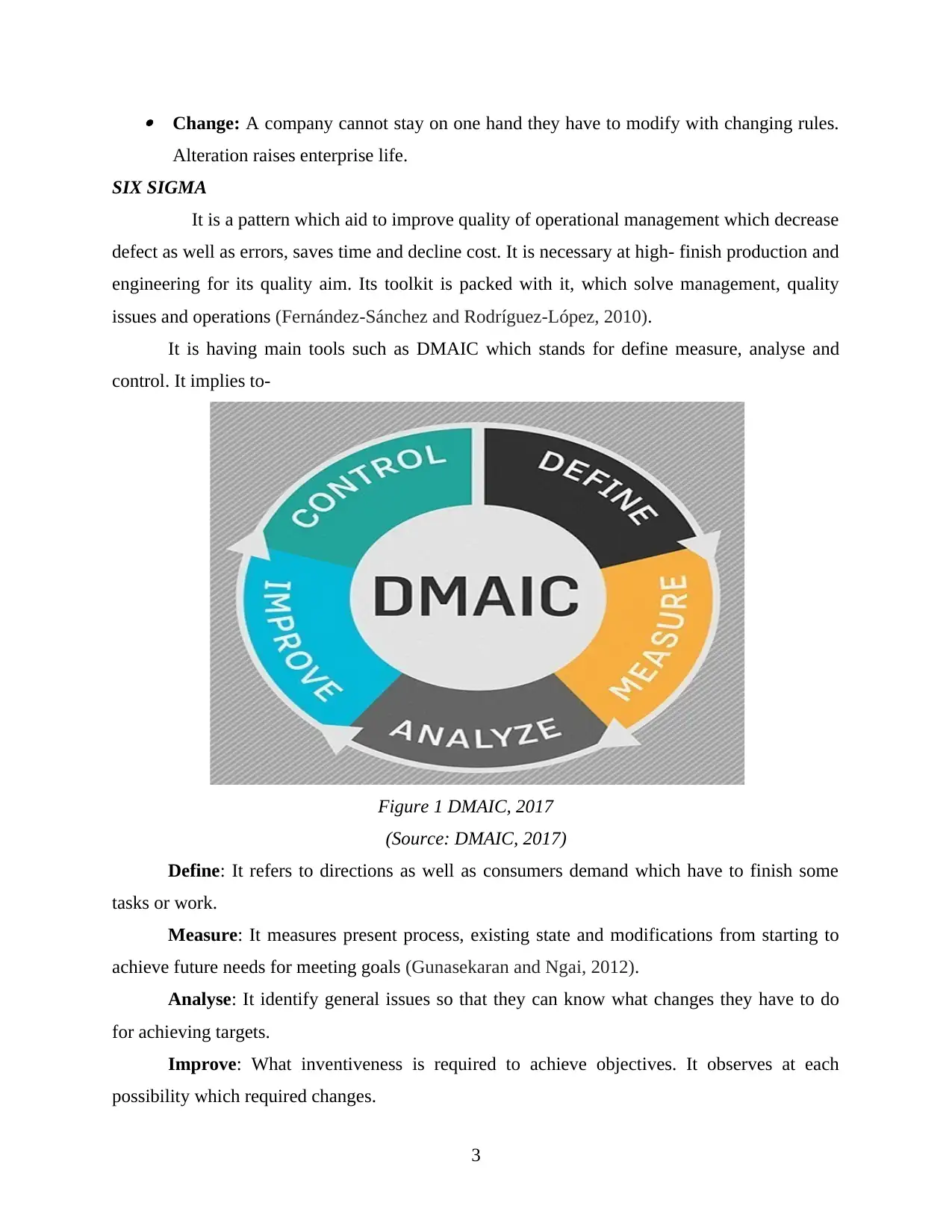
Change: A company cannot stay on one hand they have to modify with changing rules.
Alteration raises enterprise life.
SIX SIGMA
It is a pattern which aid to improve quality of operational management which decrease
defect as well as errors, saves time and decline cost. It is necessary at high- finish production and
engineering for its quality aim. Its toolkit is packed with it, which solve management, quality
issues and operations (Fernández-Sánchez and Rodríguez-López, 2010).
It is having main tools such as DMAIC which stands for define measure, analyse and
control. It implies to-
Figure 1 DMAIC, 2017
(Source: DMAIC, 2017)
Define: It refers to directions as well as consumers demand which have to finish some
tasks or work.
Measure: It measures present process, existing state and modifications from starting to
achieve future needs for meeting goals (Gunasekaran and Ngai, 2012).
Analyse: It identify general issues so that they can know what changes they have to do
for achieving targets.
Improve: What inventiveness is required to achieve objectives. It observes at each
possibility which required changes.
3
Alteration raises enterprise life.
SIX SIGMA
It is a pattern which aid to improve quality of operational management which decrease
defect as well as errors, saves time and decline cost. It is necessary at high- finish production and
engineering for its quality aim. Its toolkit is packed with it, which solve management, quality
issues and operations (Fernández-Sánchez and Rodríguez-López, 2010).
It is having main tools such as DMAIC which stands for define measure, analyse and
control. It implies to-
Figure 1 DMAIC, 2017
(Source: DMAIC, 2017)
Define: It refers to directions as well as consumers demand which have to finish some
tasks or work.
Measure: It measures present process, existing state and modifications from starting to
achieve future needs for meeting goals (Gunasekaran and Ngai, 2012).
Analyse: It identify general issues so that they can know what changes they have to do
for achieving targets.
Improve: What inventiveness is required to achieve objectives. It observes at each
possibility which required changes.
3
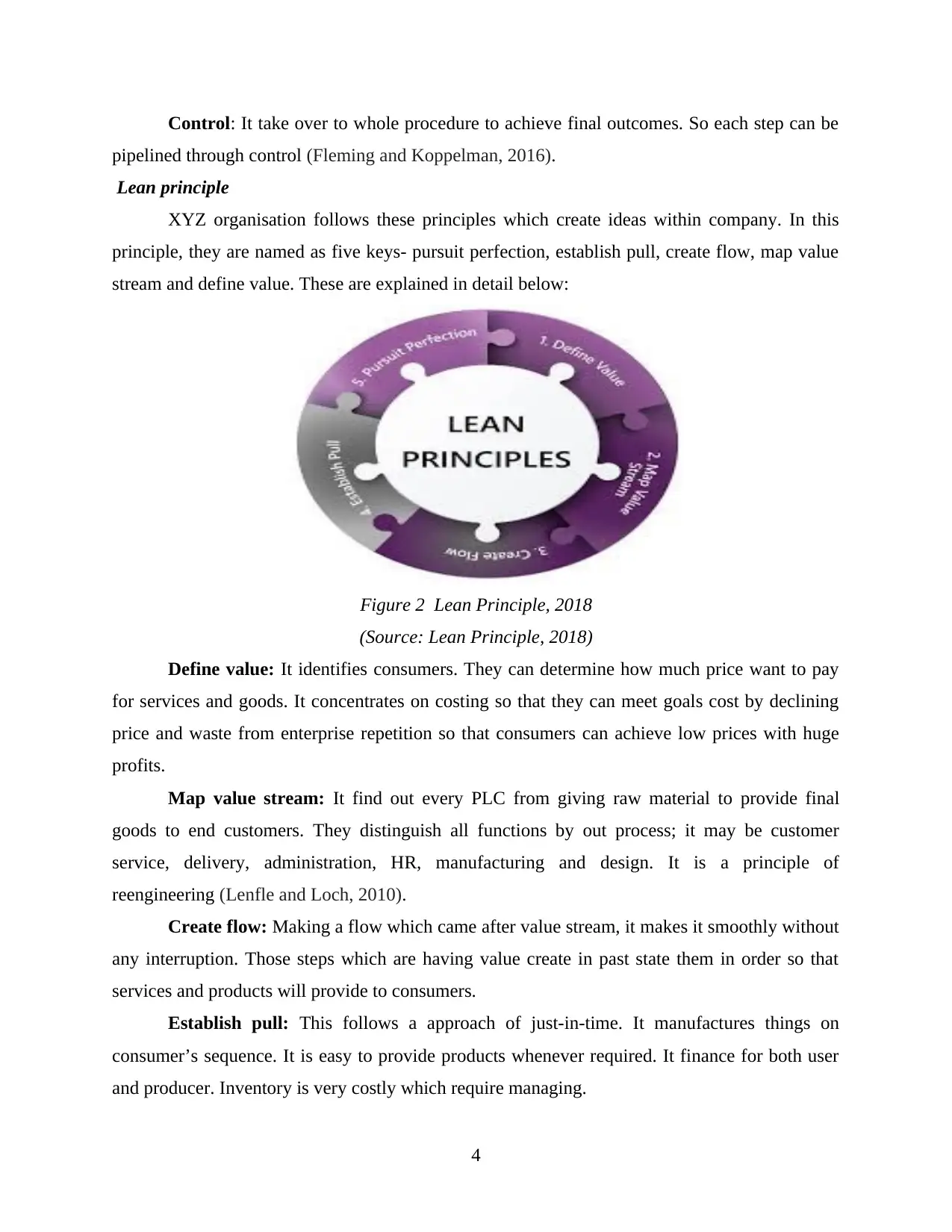
Control: It take over to whole procedure to achieve final outcomes. So each step can be
pipelined through control (Fleming and Koppelman, 2016).
Lean principle
XYZ organisation follows these principles which create ideas within company. In this
principle, they are named as five keys- pursuit perfection, establish pull, create flow, map value
stream and define value. These are explained in detail below:
Figure 2 Lean Principle, 2018
(Source: Lean Principle, 2018)
Define value: It identifies consumers. They can determine how much price want to pay
for services and goods. It concentrates on costing so that they can meet goals cost by declining
price and waste from enterprise repetition so that consumers can achieve low prices with huge
profits.
Map value stream: It find out every PLC from giving raw material to provide final
goods to end customers. They distinguish all functions by out process; it may be customer
service, delivery, administration, HR, manufacturing and design. It is a principle of
reengineering (Lenfle and Loch, 2010).
Create flow: Making a flow which came after value stream, it makes it smoothly without
any interruption. Those steps which are having value create in past state them in order so that
services and products will provide to consumers.
Establish pull: This follows a approach of just-in-time. It manufactures things on
consumer’s sequence. It is easy to provide products whenever required. It finance for both user
and producer. Inventory is very costly which require managing.
4
pipelined through control (Fleming and Koppelman, 2016).
Lean principle
XYZ organisation follows these principles which create ideas within company. In this
principle, they are named as five keys- pursuit perfection, establish pull, create flow, map value
stream and define value. These are explained in detail below:
Figure 2 Lean Principle, 2018
(Source: Lean Principle, 2018)
Define value: It identifies consumers. They can determine how much price want to pay
for services and goods. It concentrates on costing so that they can meet goals cost by declining
price and waste from enterprise repetition so that consumers can achieve low prices with huge
profits.
Map value stream: It find out every PLC from giving raw material to provide final
goods to end customers. They distinguish all functions by out process; it may be customer
service, delivery, administration, HR, manufacturing and design. It is a principle of
reengineering (Lenfle and Loch, 2010).
Create flow: Making a flow which came after value stream, it makes it smoothly without
any interruption. Those steps which are having value create in past state them in order so that
services and products will provide to consumers.
Establish pull: This follows a approach of just-in-time. It manufactures things on
consumer’s sequence. It is easy to provide products whenever required. It finance for both user
and producer. Inventory is very costly which require managing.
4
⊘ This is a preview!⊘
Do you want full access?
Subscribe today to unlock all pages.

Trusted by 1+ million students worldwide
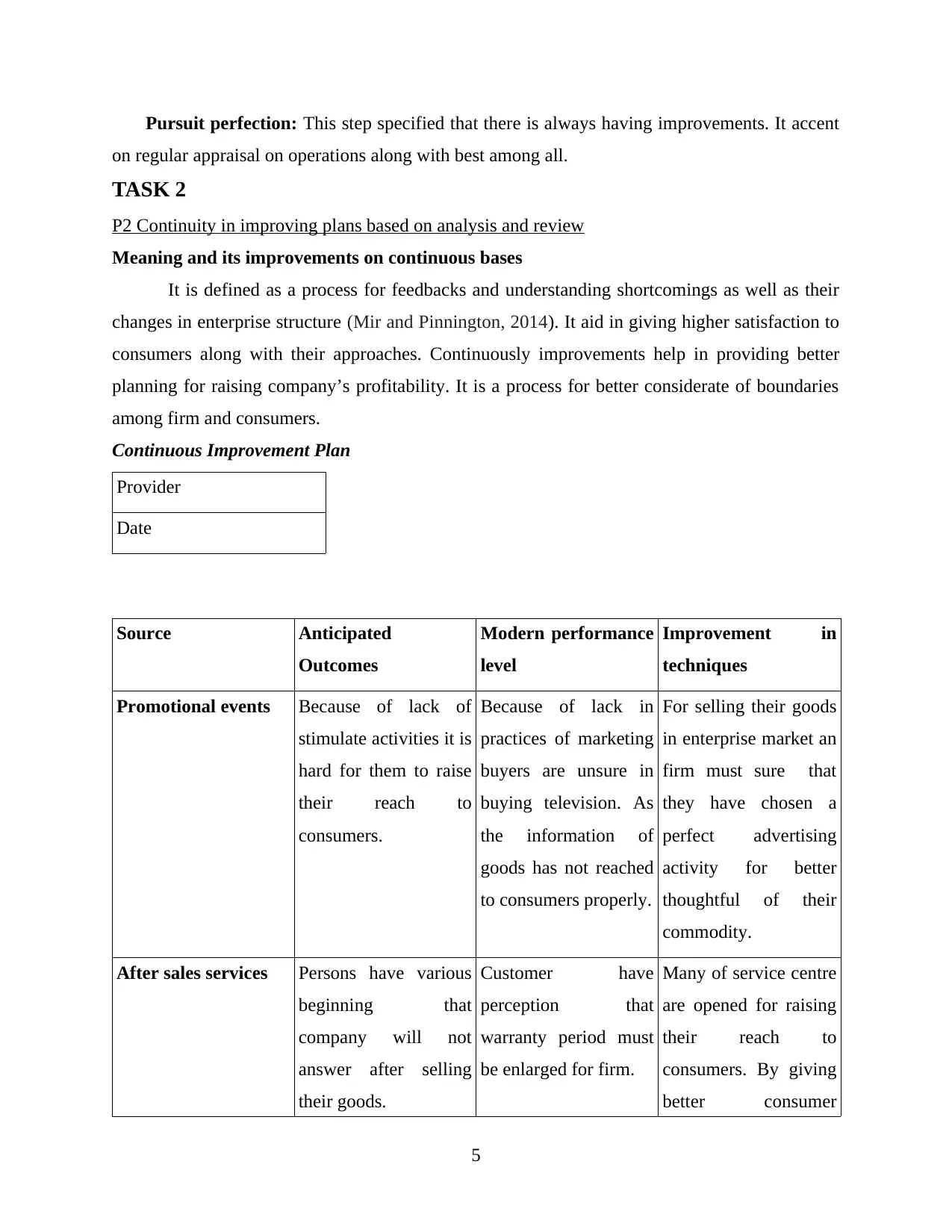
Pursuit perfection: This step specified that there is always having improvements. It accent
on regular appraisal on operations along with best among all.
TASK 2
P2 Continuity in improving plans based on analysis and review
Meaning and its improvements on continuous bases
It is defined as a process for feedbacks and understanding shortcomings as well as their
changes in enterprise structure (Mir and Pinnington, 2014). It aid in giving higher satisfaction to
consumers along with their approaches. Continuously improvements help in providing better
planning for raising company’s profitability. It is a process for better considerate of boundaries
among firm and consumers.
Continuous Improvement Plan
Provider
Date
Source Anticipated
Outcomes
Modern performance
level
Improvement in
techniques
Promotional events Because of lack of
stimulate activities it is
hard for them to raise
their reach to
consumers.
Because of lack in
practices of marketing
buyers are unsure in
buying television. As
the information of
goods has not reached
to consumers properly.
For selling their goods
in enterprise market an
firm must sure that
they have chosen a
perfect advertising
activity for better
thoughtful of their
commodity.
After sales services Persons have various
beginning that
company will not
answer after selling
their goods.
Customer have
perception that
warranty period must
be enlarged for firm.
Many of service centre
are opened for raising
their reach to
consumers. By giving
better consumer
5
on regular appraisal on operations along with best among all.
TASK 2
P2 Continuity in improving plans based on analysis and review
Meaning and its improvements on continuous bases
It is defined as a process for feedbacks and understanding shortcomings as well as their
changes in enterprise structure (Mir and Pinnington, 2014). It aid in giving higher satisfaction to
consumers along with their approaches. Continuously improvements help in providing better
planning for raising company’s profitability. It is a process for better considerate of boundaries
among firm and consumers.
Continuous Improvement Plan
Provider
Date
Source Anticipated
Outcomes
Modern performance
level
Improvement in
techniques
Promotional events Because of lack of
stimulate activities it is
hard for them to raise
their reach to
consumers.
Because of lack in
practices of marketing
buyers are unsure in
buying television. As
the information of
goods has not reached
to consumers properly.
For selling their goods
in enterprise market an
firm must sure that
they have chosen a
perfect advertising
activity for better
thoughtful of their
commodity.
After sales services Persons have various
beginning that
company will not
answer after selling
their goods.
Customer have
perception that
warranty period must
be enlarged for firm.
Many of service centre
are opened for raising
their reach to
consumers. By giving
better consumer
5
Paraphrase This Document
Need a fresh take? Get an instant paraphrase of this document with our AI Paraphraser
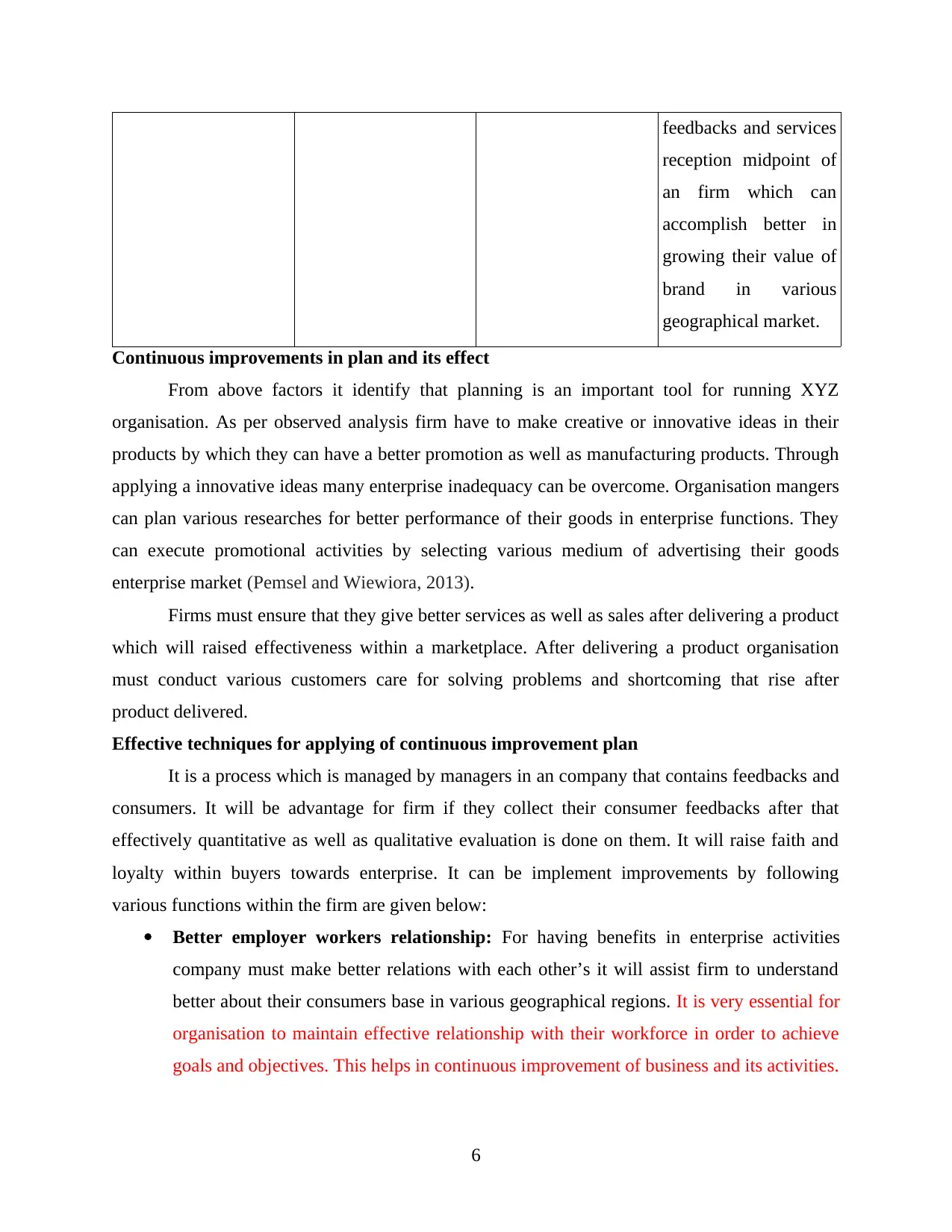
feedbacks and services
reception midpoint of
an firm which can
accomplish better in
growing their value of
brand in various
geographical market.
Continuous improvements in plan and its effect
From above factors it identify that planning is an important tool for running XYZ
organisation. As per observed analysis firm have to make creative or innovative ideas in their
products by which they can have a better promotion as well as manufacturing products. Through
applying a innovative ideas many enterprise inadequacy can be overcome. Organisation mangers
can plan various researches for better performance of their goods in enterprise functions. They
can execute promotional activities by selecting various medium of advertising their goods
enterprise market (Pemsel and Wiewiora, 2013).
Firms must ensure that they give better services as well as sales after delivering a product
which will raised effectiveness within a marketplace. After delivering a product organisation
must conduct various customers care for solving problems and shortcoming that rise after
product delivered.
Effective techniques for applying of continuous improvement plan
It is a process which is managed by managers in an company that contains feedbacks and
consumers. It will be advantage for firm if they collect their consumer feedbacks after that
effectively quantitative as well as qualitative evaluation is done on them. It will raise faith and
loyalty within buyers towards enterprise. It can be implement improvements by following
various functions within the firm are given below:
Better employer workers relationship: For having benefits in enterprise activities
company must make better relations with each other’s it will assist firm to understand
better about their consumers base in various geographical regions. It is very essential for
organisation to maintain effective relationship with their workforce in order to achieve
goals and objectives. This helps in continuous improvement of business and its activities.
6
reception midpoint of
an firm which can
accomplish better in
growing their value of
brand in various
geographical market.
Continuous improvements in plan and its effect
From above factors it identify that planning is an important tool for running XYZ
organisation. As per observed analysis firm have to make creative or innovative ideas in their
products by which they can have a better promotion as well as manufacturing products. Through
applying a innovative ideas many enterprise inadequacy can be overcome. Organisation mangers
can plan various researches for better performance of their goods in enterprise functions. They
can execute promotional activities by selecting various medium of advertising their goods
enterprise market (Pemsel and Wiewiora, 2013).
Firms must ensure that they give better services as well as sales after delivering a product
which will raised effectiveness within a marketplace. After delivering a product organisation
must conduct various customers care for solving problems and shortcoming that rise after
product delivered.
Effective techniques for applying of continuous improvement plan
It is a process which is managed by managers in an company that contains feedbacks and
consumers. It will be advantage for firm if they collect their consumer feedbacks after that
effectively quantitative as well as qualitative evaluation is done on them. It will raise faith and
loyalty within buyers towards enterprise. It can be implement improvements by following
various functions within the firm are given below:
Better employer workers relationship: For having benefits in enterprise activities
company must make better relations with each other’s it will assist firm to understand
better about their consumers base in various geographical regions. It is very essential for
organisation to maintain effective relationship with their workforce in order to achieve
goals and objectives. This helps in continuous improvement of business and its activities.
6
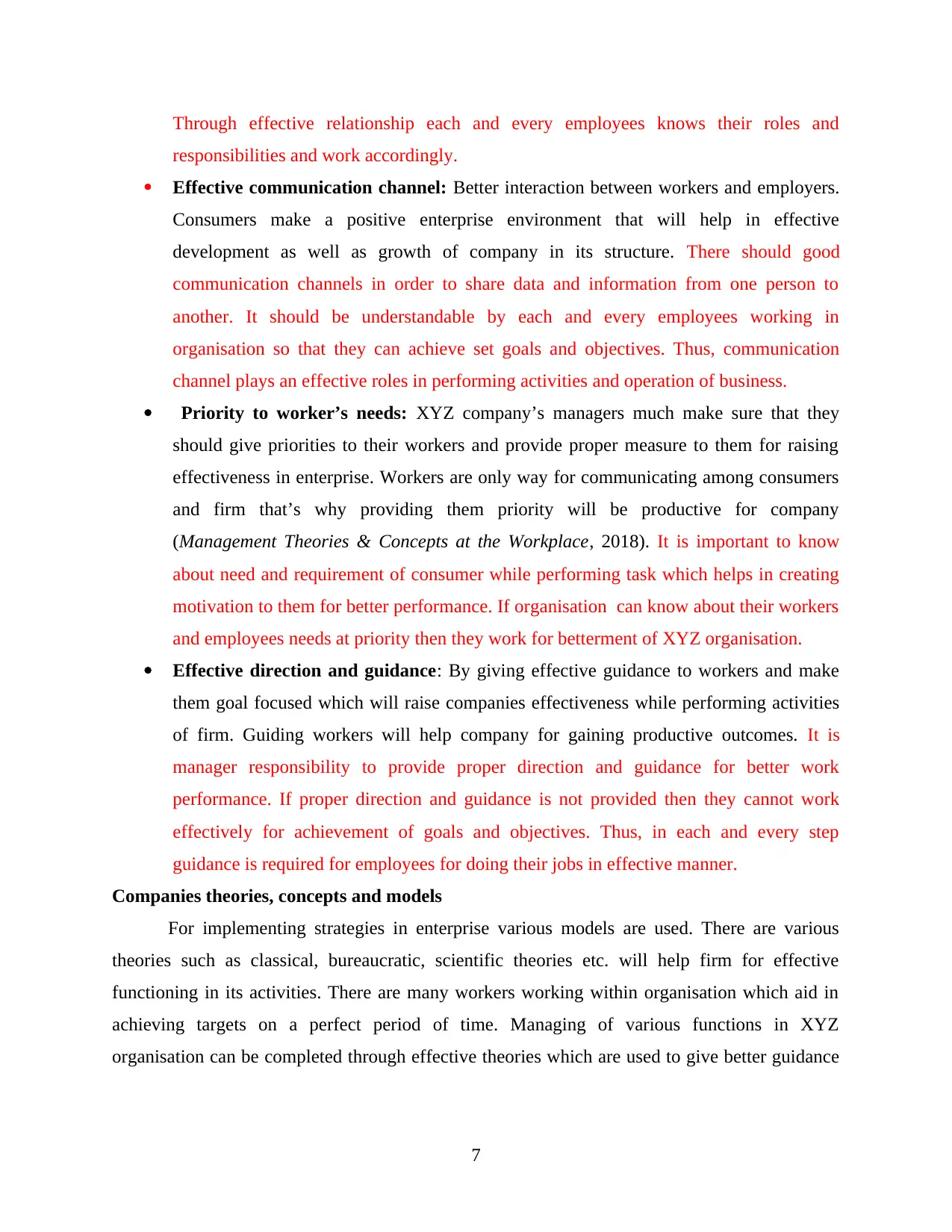
Through effective relationship each and every employees knows their roles and
responsibilities and work accordingly.
Effective communication channel: Better interaction between workers and employers.
Consumers make a positive enterprise environment that will help in effective
development as well as growth of company in its structure. There should good
communication channels in order to share data and information from one person to
another. It should be understandable by each and every employees working in
organisation so that they can achieve set goals and objectives. Thus, communication
channel plays an effective roles in performing activities and operation of business.
Priority to worker’s needs: XYZ company’s managers much make sure that they
should give priorities to their workers and provide proper measure to them for raising
effectiveness in enterprise. Workers are only way for communicating among consumers
and firm that’s why providing them priority will be productive for company
(Management Theories & Concepts at the Workplace, 2018). It is important to know
about need and requirement of consumer while performing task which helps in creating
motivation to them for better performance. If organisation can know about their workers
and employees needs at priority then they work for betterment of XYZ organisation.
Effective direction and guidance: By giving effective guidance to workers and make
them goal focused which will raise companies effectiveness while performing activities
of firm. Guiding workers will help company for gaining productive outcomes. It is
manager responsibility to provide proper direction and guidance for better work
performance. If proper direction and guidance is not provided then they cannot work
effectively for achievement of goals and objectives. Thus, in each and every step
guidance is required for employees for doing their jobs in effective manner.
Companies theories, concepts and models
For implementing strategies in enterprise various models are used. There are various
theories such as classical, bureaucratic, scientific theories etc. will help firm for effective
functioning in its activities. There are many workers working within organisation which aid in
achieving targets on a perfect period of time. Managing of various functions in XYZ
organisation can be completed through effective theories which are used to give better guidance
7
responsibilities and work accordingly.
Effective communication channel: Better interaction between workers and employers.
Consumers make a positive enterprise environment that will help in effective
development as well as growth of company in its structure. There should good
communication channels in order to share data and information from one person to
another. It should be understandable by each and every employees working in
organisation so that they can achieve set goals and objectives. Thus, communication
channel plays an effective roles in performing activities and operation of business.
Priority to worker’s needs: XYZ company’s managers much make sure that they
should give priorities to their workers and provide proper measure to them for raising
effectiveness in enterprise. Workers are only way for communicating among consumers
and firm that’s why providing them priority will be productive for company
(Management Theories & Concepts at the Workplace, 2018). It is important to know
about need and requirement of consumer while performing task which helps in creating
motivation to them for better performance. If organisation can know about their workers
and employees needs at priority then they work for betterment of XYZ organisation.
Effective direction and guidance: By giving effective guidance to workers and make
them goal focused which will raise companies effectiveness while performing activities
of firm. Guiding workers will help company for gaining productive outcomes. It is
manager responsibility to provide proper direction and guidance for better work
performance. If proper direction and guidance is not provided then they cannot work
effectively for achievement of goals and objectives. Thus, in each and every step
guidance is required for employees for doing their jobs in effective manner.
Companies theories, concepts and models
For implementing strategies in enterprise various models are used. There are various
theories such as classical, bureaucratic, scientific theories etc. will help firm for effective
functioning in its activities. There are many workers working within organisation which aid in
achieving targets on a perfect period of time. Managing of various functions in XYZ
organisation can be completed through effective theories which are used to give better guidance
7
⊘ This is a preview!⊘
Do you want full access?
Subscribe today to unlock all pages.

Trusted by 1+ million students worldwide
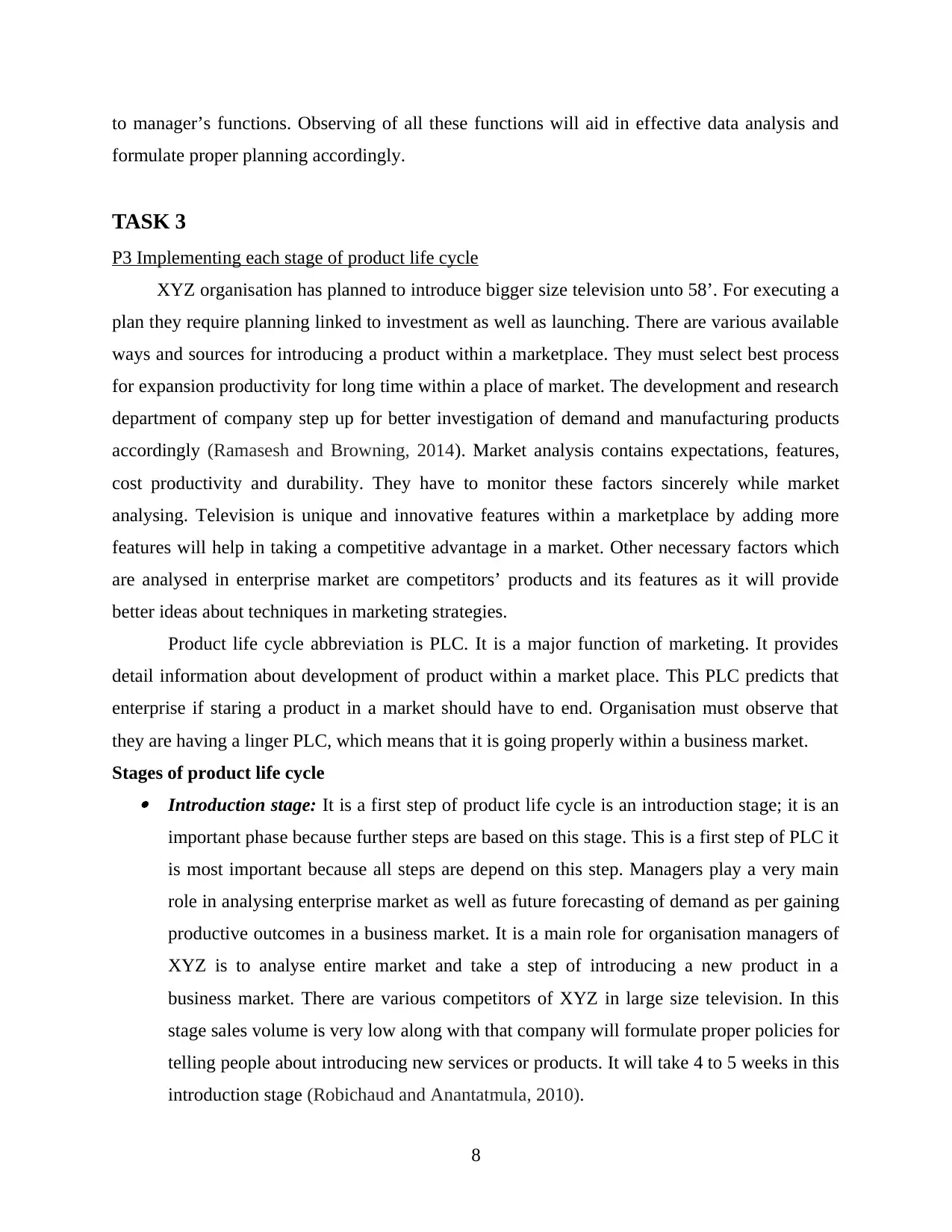
to manager’s functions. Observing of all these functions will aid in effective data analysis and
formulate proper planning accordingly.
TASK 3
P3 Implementing each stage of product life cycle
XYZ organisation has planned to introduce bigger size television unto 58’. For executing a
plan they require planning linked to investment as well as launching. There are various available
ways and sources for introducing a product within a marketplace. They must select best process
for expansion productivity for long time within a place of market. The development and research
department of company step up for better investigation of demand and manufacturing products
accordingly (Ramasesh and Browning, 2014). Market analysis contains expectations, features,
cost productivity and durability. They have to monitor these factors sincerely while market
analysing. Television is unique and innovative features within a marketplace by adding more
features will help in taking a competitive advantage in a market. Other necessary factors which
are analysed in enterprise market are competitors’ products and its features as it will provide
better ideas about techniques in marketing strategies.
Product life cycle abbreviation is PLC. It is a major function of marketing. It provides
detail information about development of product within a market place. This PLC predicts that
enterprise if staring a product in a market should have to end. Organisation must observe that
they are having a linger PLC, which means that it is going properly within a business market.
Stages of product life cycle Introduction stage: It is a first step of product life cycle is an introduction stage; it is an
important phase because further steps are based on this stage. This is a first step of PLC it
is most important because all steps are depend on this step. Managers play a very main
role in analysing enterprise market as well as future forecasting of demand as per gaining
productive outcomes in a business market. It is a main role for organisation managers of
XYZ is to analyse entire market and take a step of introducing a new product in a
business market. There are various competitors of XYZ in large size television. In this
stage sales volume is very low along with that company will formulate proper policies for
telling people about introducing new services or products. It will take 4 to 5 weeks in this
introduction stage (Robichaud and Anantatmula, 2010).
8
formulate proper planning accordingly.
TASK 3
P3 Implementing each stage of product life cycle
XYZ organisation has planned to introduce bigger size television unto 58’. For executing a
plan they require planning linked to investment as well as launching. There are various available
ways and sources for introducing a product within a marketplace. They must select best process
for expansion productivity for long time within a place of market. The development and research
department of company step up for better investigation of demand and manufacturing products
accordingly (Ramasesh and Browning, 2014). Market analysis contains expectations, features,
cost productivity and durability. They have to monitor these factors sincerely while market
analysing. Television is unique and innovative features within a marketplace by adding more
features will help in taking a competitive advantage in a market. Other necessary factors which
are analysed in enterprise market are competitors’ products and its features as it will provide
better ideas about techniques in marketing strategies.
Product life cycle abbreviation is PLC. It is a major function of marketing. It provides
detail information about development of product within a market place. This PLC predicts that
enterprise if staring a product in a market should have to end. Organisation must observe that
they are having a linger PLC, which means that it is going properly within a business market.
Stages of product life cycle Introduction stage: It is a first step of product life cycle is an introduction stage; it is an
important phase because further steps are based on this stage. This is a first step of PLC it
is most important because all steps are depend on this step. Managers play a very main
role in analysing enterprise market as well as future forecasting of demand as per gaining
productive outcomes in a business market. It is a main role for organisation managers of
XYZ is to analyse entire market and take a step of introducing a new product in a
business market. There are various competitors of XYZ in large size television. In this
stage sales volume is very low along with that company will formulate proper policies for
telling people about introducing new services or products. It will take 4 to 5 weeks in this
introduction stage (Robichaud and Anantatmula, 2010).
8
Paraphrase This Document
Need a fresh take? Get an instant paraphrase of this document with our AI Paraphraser
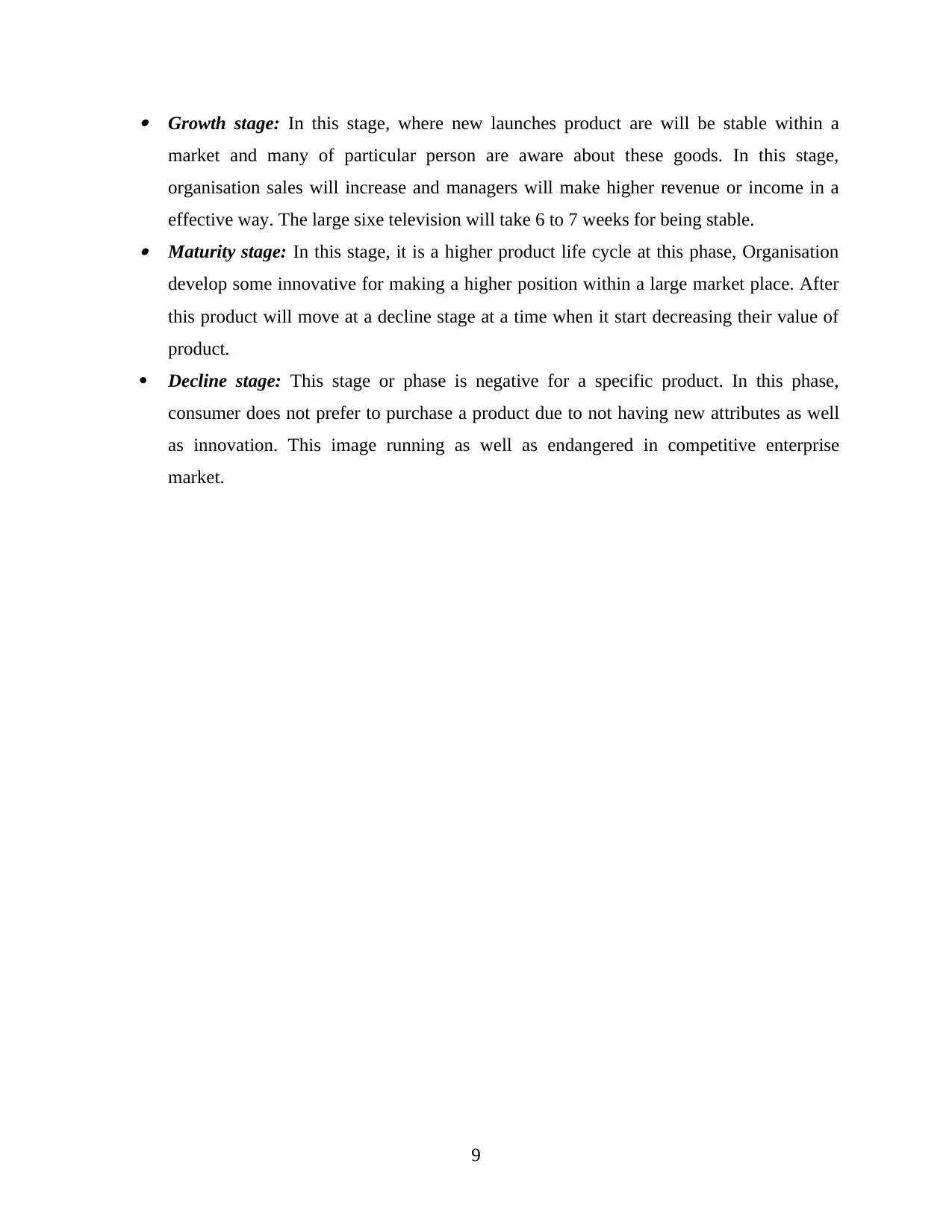
Growth stage: In this stage, where new launches product are will be stable within a
market and many of particular person are aware about these goods. In this stage,
organisation sales will increase and managers will make higher revenue or income in a
effective way. The large sixe television will take 6 to 7 weeks for being stable. Maturity stage: In this stage, it is a higher product life cycle at this phase, Organisation
develop some innovative for making a higher position within a large market place. After
this product will move at a decline stage at a time when it start decreasing their value of
product.
Decline stage: This stage or phase is negative for a specific product. In this phase,
consumer does not prefer to purchase a product due to not having new attributes as well
as innovation. This image running as well as endangered in competitive enterprise
market.
9
market and many of particular person are aware about these goods. In this stage,
organisation sales will increase and managers will make higher revenue or income in a
effective way. The large sixe television will take 6 to 7 weeks for being stable. Maturity stage: In this stage, it is a higher product life cycle at this phase, Organisation
develop some innovative for making a higher position within a large market place. After
this product will move at a decline stage at a time when it start decreasing their value of
product.
Decline stage: This stage or phase is negative for a specific product. In this phase,
consumer does not prefer to purchase a product due to not having new attributes as well
as innovation. This image running as well as endangered in competitive enterprise
market.
9
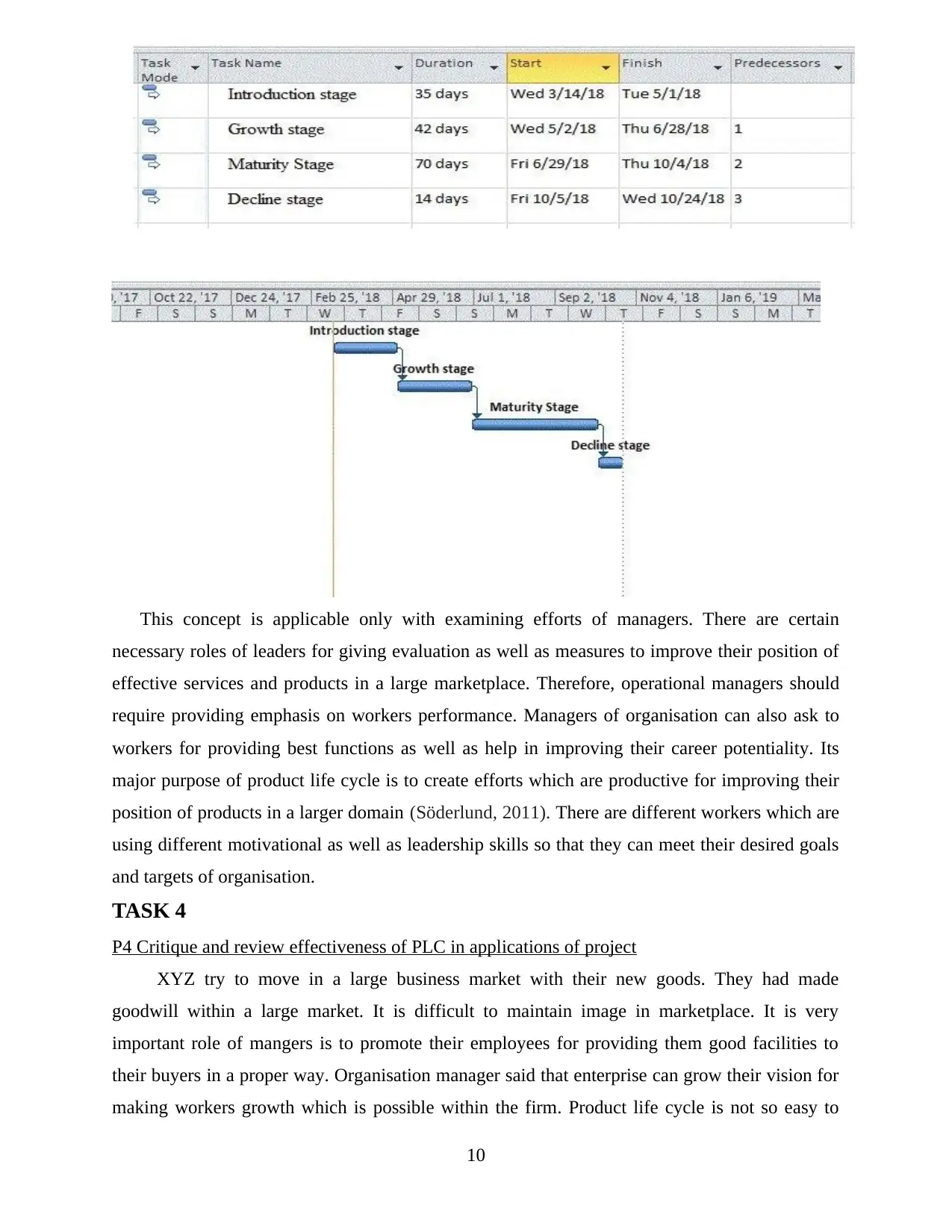
This concept is applicable only with examining efforts of managers. There are certain
necessary roles of leaders for giving evaluation as well as measures to improve their position of
effective services and products in a large marketplace. Therefore, operational managers should
require providing emphasis on workers performance. Managers of organisation can also ask to
workers for providing best functions as well as help in improving their career potentiality. Its
major purpose of product life cycle is to create efforts which are productive for improving their
position of products in a larger domain (Söderlund, 2011). There are different workers which are
using different motivational as well as leadership skills so that they can meet their desired goals
and targets of organisation.
TASK 4
P4 Critique and review effectiveness of PLC in applications of project
XYZ try to move in a large business market with their new goods. They had made
goodwill within a large market. It is difficult to maintain image in marketplace. It is very
important role of mangers is to promote their employees for providing them good facilities to
their buyers in a proper way. Organisation manager said that enterprise can grow their vision for
making workers growth which is possible within the firm. Product life cycle is not so easy to
10
necessary roles of leaders for giving evaluation as well as measures to improve their position of
effective services and products in a large marketplace. Therefore, operational managers should
require providing emphasis on workers performance. Managers of organisation can also ask to
workers for providing best functions as well as help in improving their career potentiality. Its
major purpose of product life cycle is to create efforts which are productive for improving their
position of products in a larger domain (Söderlund, 2011). There are different workers which are
using different motivational as well as leadership skills so that they can meet their desired goals
and targets of organisation.
TASK 4
P4 Critique and review effectiveness of PLC in applications of project
XYZ try to move in a large business market with their new goods. They had made
goodwill within a large market. It is difficult to maintain image in marketplace. It is very
important role of mangers is to promote their employees for providing them good facilities to
their buyers in a proper way. Organisation manager said that enterprise can grow their vision for
making workers growth which is possible within the firm. Product life cycle is not so easy to
10
⊘ This is a preview!⊘
Do you want full access?
Subscribe today to unlock all pages.

Trusted by 1+ million students worldwide
1 out of 18
Related Documents
Your All-in-One AI-Powered Toolkit for Academic Success.
+13062052269
info@desklib.com
Available 24*7 on WhatsApp / Email
![[object Object]](/_next/static/media/star-bottom.7253800d.svg)
Unlock your academic potential
Copyright © 2020–2025 A2Z Services. All Rights Reserved. Developed and managed by ZUCOL.





